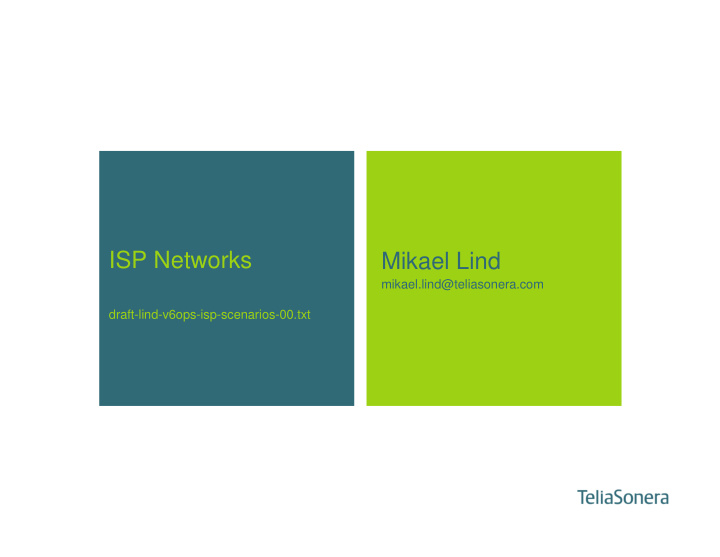



ISP Networks Mikael Lind mikael.lind@teliasonera.com draft-lind-v6ops-isp-scenarios-00.txt
Team members • Mikael Lind • Aidan Williams isp@v6ops.euro6ix.net • Alain Baudot • Cleveland Mickles • Jae-Hwoon Lee • Jasminko Mulahusic • Jordi Palet • Myung-Ki Shin • Vladimir Ksinant • Soohong Daniel Park • Suresh Satapati 2
The beginning • Set out on the same path as the other design teams • Goal: identify needed coexistence mechanism • Two documents, Cases and Analysis • A first cases/scenarios document was written before the 56th meeting – Described different network types – Became extensive, >80 pages – Lacked IPv6 information • An effort was made to add IPv6 issues – Proved difficult, hard not to hint solutions • An outline to a analysis document written 3
Next step • Rewriting the existing documents was deemed to difficult • A change needed, focus on IPv6 migration not on technical details • New approach presented at the last meeting – Reduce the network details – Add IPv6 introduction scenarios • The new approach proved difficult as well – Difficult not to hint solutions – Difficult to limit the scenarios 4
A new try • draft-lind-v6ops-isp-scenarios-00.txt • A further simplification • Defines a generic ISP network • Defines stages of IPv6 maturity in the network • Defines migration scenarios between the stages • Limited in detail • Leaves out IPv6 only networks • Gives a simplified view of the world • Should apply to most ISP networks 5
Scenarios draft • Defines a simple generic ISP network that consists of a core and access part and peers through exchange points or directly __________ _________ | | | | |Backoffice|----| CORE | |__________| |_________|\ . / | \ \ . / | \ \_Peering( Direct & IX ) . / | \ . / | \ ___.___ / ___|___ \ _______ | |____/ | | \____| | |Access1| |Access2| |Access3| |_______| |_______| |_______| | | | | | | ISP Network ----|---------------|---------------|----------------- | | | Customer Networks ___|____ ___|____ ___|____ | | | | | | |Customer| |Customer| |Customer| |________| |________| |________| 6
Scenarios draft • The ISP network is said to exist in different stages – It can be in the original stage which is all IPv4 – It can be partially upgraded to support both IPv4 and IPv6 in parts of the network – It can be fully upgraded to support IPv4 and IPv6 in all parts of the network • In order to move from one stage to another there has to be a transition • These transitions are defined as different transition scenarios • The transition scenarios will be the basis for the migration in the solution document • Is this view too simplified? 7
A new path • Focus on a document for the ISPs • Not be intended to define all coexistence mechanisms 8
Decision point • Continue on the old track • Refocus the work – Change the intent of the documents – Write a guide for ISPs 9
Why change goals? • Previously experienced problems – A change will probably allow easier useful progress • Lack of interest – A guide for ISPs might create more interest for the work 10
What will this change lead to? • A scenarios document similar to draft-lind-v6ops-isp-00.txt • A solutions document that is a guide for ISPs – Take a more practical approach to the ISPs IPv6 issues – Solutions for different network types – Definition of different networks can hopefully be reused from the first cases document. – Provide a guideline for ISPs on how the IPv6 migration can be done – Will indirectly identify coexistence mechanisms • Multiple documents for the solutions is a possibility – Would allow different areas to progress separately – Will prevent the task from getting to big 11
Content of solutions document • Describe the migration process for ISP networks • Point out difficulties and risk with different migration methods • Answer questions like: How to transition my existing IGP ? • Handle different network types like DSL, Cable and so on separately • Point out what equipment is affected by the migration • Review the use of different coexistence mechanisms • Limit the migration process to what is described in the scenarios doc – No IPv6 only service 12
A third choice • End the ISP work • If there isn’t enough interest it perhaps shouldn’t be done • Not the right choice, there is a need to help the ISP with the IPv6 migration 13
Conclusions • A change is needed • Have to focus on the ISPs need from a practical standpoint • Need to gain more interest 14
Questions • Should we write an ISP guide? If yes: • Should we write separate migration instructions for different network types? • Is the scenarios document useful when writing the ISP guide? If it is: • Can we keep the existing generic network view? • Are the stages and scenarios reasonable ? 15
The future • Other suggestions or questions? • Interested in helping out? • Discussion on how the work within the ISP team should be divided today at 18.00 in this room, will continue at the social event 16
Recommend
More recommend